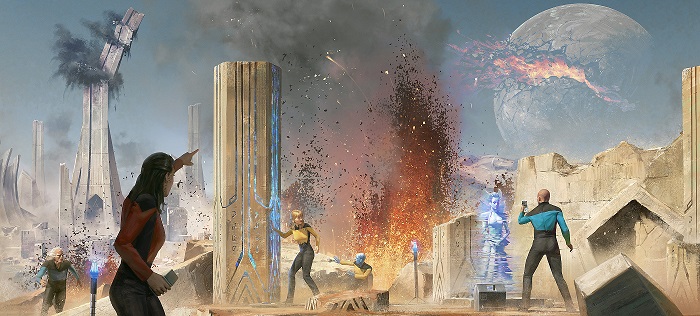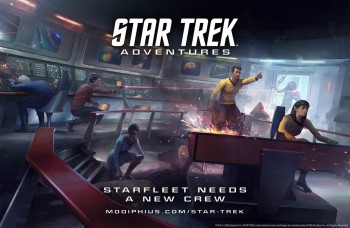Modular: Boldly Go … with Star Trek Adventures RPG Playtest
A Starfleet Away Team encounters some complications in the Star Trek Adventures RPG
Though Star Trek is one of the most popular franchises in science fiction and fantasy, it’s been over a decade since there has been a tabletop roleplaying game in production set in the Star Trek universe. That’s about to change in 2017 with the release of Star Trek Adventures from Modiphius Games.
The game is currently in development, but if you’re interested in checking it out, you don’t have to wait until 2017. Modiphius has just begun an open alpha playtest, allowing people across the world to begin playing games set in the world, test out the rules system, and provide feedback in time for the final design of the game.
Last Friday, I was able to get together a group to do a trial run of the first open playtest adventure. Though there’s no telling exactly which mechanics will stay the same through the playtest process, what is clear at this very early stage is that Modiphius is putting together a game that captures the feel of Star Trek in a tabletop roleplaying game.
Cooperation & Teamwork
One of the elements of the system that I was most impressed with is that it is uniquely designed to facilitate teamwork, in a way that I’ve seen few other roleplaying games capture. The first and most obvious way is that one player can easily Assist another player. For example, the first challenge in the playtest adventure is that the crew is on a shuttle that is crashing on a planet during an ion storm. The pilot at the conn is landing, using their Conn (piloting) ability to maneuver the ship into a landing. The engineer character is at the Ops station, and they can use their Engineering skill to try to keep the ship’s systems functioning through the landing process. The total successes of both rolls are added together to determine the total successes of the landing … meaning, among other things, that a mediocre pilot can complete the challenge if there’s a great engineer assisting.
Momentum & Threat
If you complete Tasks by rolling more successes than you need, including successes generated by Assist actions, then these extra successes generate Momentum points, which can be spent to increase the scope of success. In the landing scenario above, it is Difficulty 2 to land the ship, so that takes 2 successes. If you get 4 successes, you generate 2 Momentum, which can be spent immediately to land closer to the science outpost you’re trying to find. (Basically, you remove one of the challenges you encounter on the way to the outpost.) In combat, Momentum can be spent to increase damage or generate other effects.
Momentum that isn’t spent in this way can go into a group Momentum pool, which players can then draw from to purchase extra dice. There are other ways that they can get extra dice, including by giving the Game Master Threat points … which basically are points that the GM can use to make things more difficult for them.
Characters, Values, & Determination
The first round of playtesting included pregenerated characters, so the character generation rules weren’t tested as part of it. Each character had an area of specialization based on Command, Conn (piloting), Engineering, Science, Security, or Medicine. The group I ran through the adventure had a Command officer, a pilot, an engineer, and a medic. None were human, so there were a mix of races: Andorian, Tellurite, Trill, and Denobulan.
But the thing that really made the characters stand apart from each other were their Values. Each character has three Values, short phrases that represent key aspects of their character. When a character is performing an action that is in accord with their Values, then they get extra Momentum if that action is successful. So when our Command officer, with the Rash and Reckless Value, attempted to cross a rocky ravine without climbing gear, they got an extra Momentum upon succeeding.
When players perform actions in conflict with their values, they not only can get some short-term benefits, but also have the opportunity to modify or completely replace that Value over the course of play. That aspect didn’t come up during this initial playtest, but for longer-terms campaign it will be an interesting component of the game mechanics that contributes to character growth and development. This is one way that you can gain points of Determination, which provides a double success to rolls.
One feature of Values and Determination that did come up, though, is that the GM has an option to bribe players based on their specific Values. In the playtest, the group had three things going on: repair the shuttle, gather science samples that were about to be ruined by radiation, and cure a radiation-based mutation that had affected the local science team on the planet. The engineer, who has the Values “Difficult to Work With” and “Outspoken and Argumentative,” had already gathered all of the parts to repair the shuttlecraft, which was a couple of hours’ walk away. While the group was trying to decide how to divide up the gathering of the samples and the medical research, I offered him a point of Determination in exchange for throwing a fit and deciding to go repair the shuttlecraft on his own, rather than waiting to help with the other projects. He accepted, earned the point of Determination, and set off with his supplies to fix the shuttlecraft. Fortunately he had an extra Determination point to help with any challenges he should encounter solo back at the shuttlecraft.
Conclusion
The game did an excellent job of feeling like an episode of Star Trek, providing the characters with clear roles in the group but also sufficient flexibility to be involved in everything that was happening. Even running a quick one-shot session with a few pregenerated characters, the familiarity of the setting made it very easy for everyone to slip into their roles and quickly get up to speed on what they were supposed to be doing. We are definitely looking forward to exploring other aspects of the game in more detail. Here are a handful of things that weren’t touched on in depth in the first playtest:
- Starship statistics and space combat wasn’t included at all
- Combat was fairly low-key. There were a couple of minor skirmishes to see how the combat mechanics worked, but this was definitely not a combat-oriented adventure … and, to some degree, I would expect and hope that combat will always be a secondary component in Star Trek Adventures
- Character generation was absent
- The only equipment involved were phasers. I am interested to see how tricorders work in game, and what other equipment, such as personal shields, might come into play.
Hopefully, the rules for these areas will prove just as engaging as the basic mechanics of the system. My group of playtesters, at least, is ready to beam up.
You can get more information about the Star Trek Adventures RPG, and sign up for the public playtest, at the Modiphius website, or if you’re a retailer you can sign up to be notified about pre-orders.
Andrew Zimmerman Jones is a writer of fiction and non-fiction. In addition to being a contributing editor to Black Gate magazine, Andrew is the author of String Theory For Dummies. He has written for About.com Physics, PBS NOVA, and assorted other publications on themes related to science and popular culture. You can follow his exploits on Facebook, Twitter, and even Google+.


These are intriguing mechanics, and Modiphius’s style of open playtest (a small, tight scenario) appears designed to stress particular aspects of the game. I expect there will be more in the future?
I like the idea of a “combat secondary” game, but that might require special players indeed! ?
Yes, there are supposed to be more playtests coming. I’ll probably do a brief update after each one, if I can. When you sign up for the playtest, you can choose being assigned to ships that are focused on combat, focused on science/exploration, and a balance of the two … which I assume means the playtest scenarios will eventually diverge, so groups are playtesting different aspects of the system. I signed up for the science/exploration vessel, but might peek at the more combat-heavy scenarios as well.